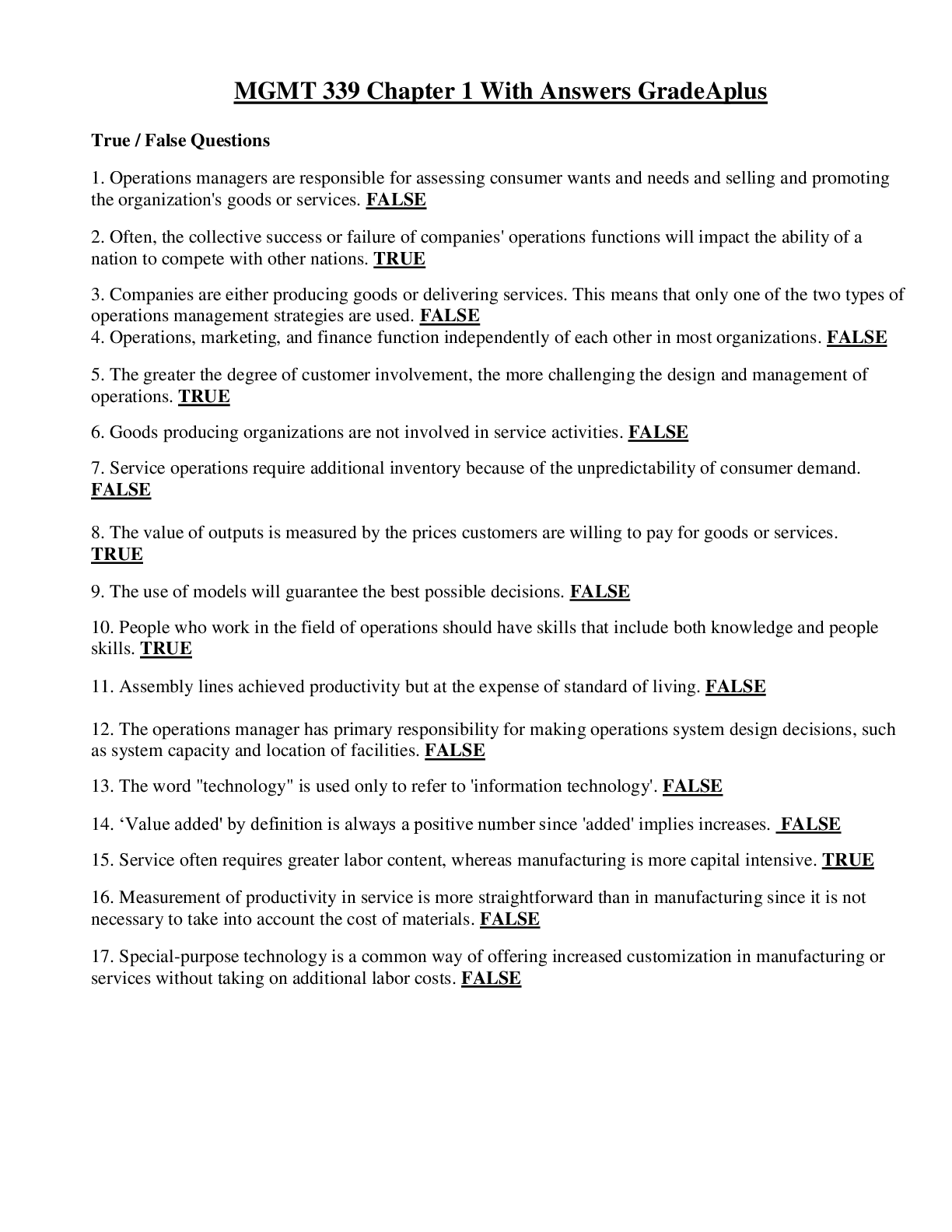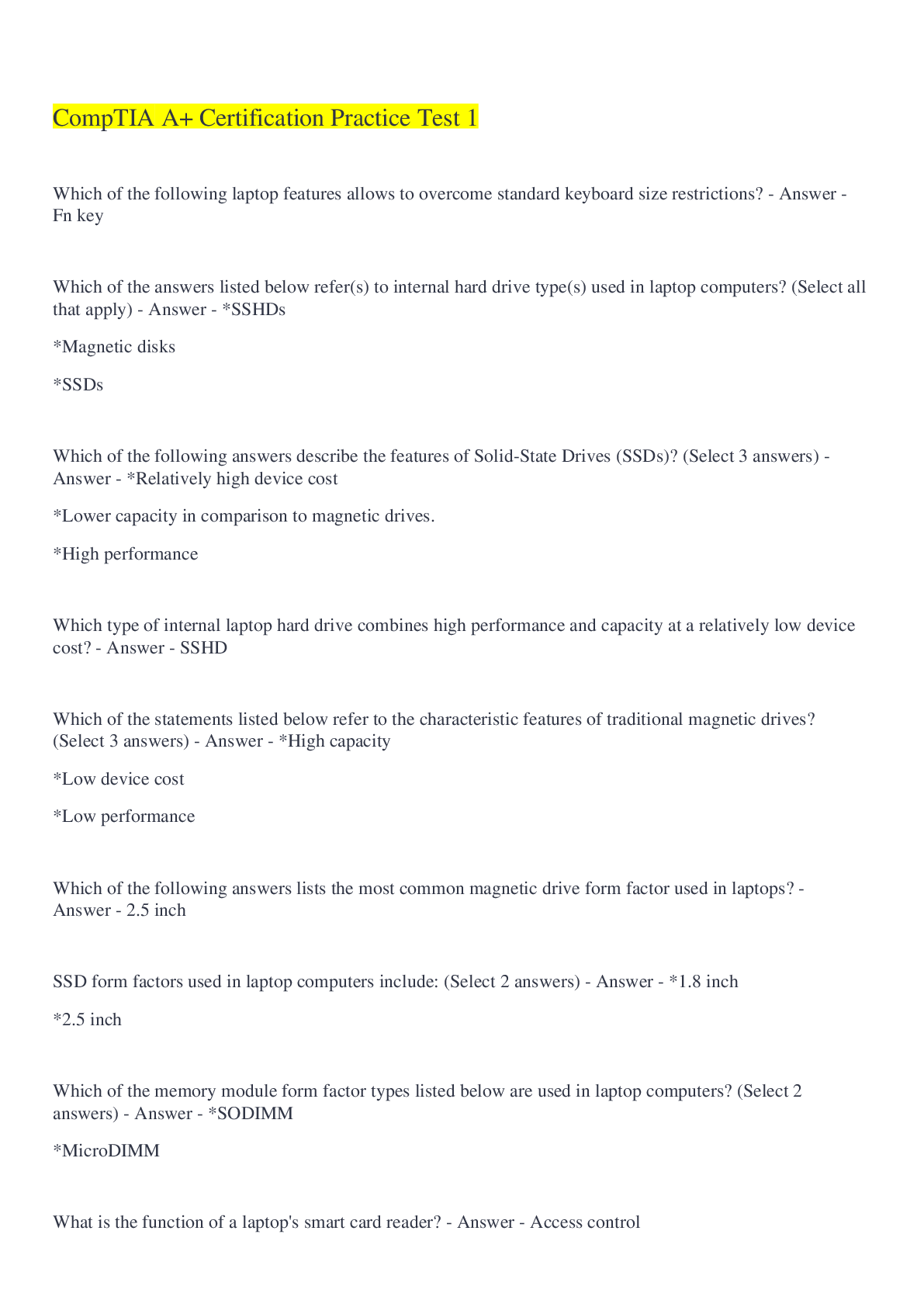Management > EXAM > MGMT 339 Chapter 1 With Answers GradeAplus (All)
MGMT 339 Chapter 1 With Answers GradeAplus
Document Content and Description Below
True / False Questions 1. Operations managers are responsible for assessing consumer wants and needs and selling and promoting the organization's goods or services. 2. Often, the collective su... ccess or failure of companies' operations functions will impact the ability of a nation to compete with other nations. 3. Companies are either producing goods or delivering services. This means that only one of the two types of operations management strategies are used. 4. Operations, marketing, and finance function independently of each other in most organizations. 5. The greater the degree of customer involvement, the more challenging the design and management of operations. 6. Goods producing organizations are not involved in service activities. 7. Service operations require additional inventory because of the unpredictability of consumer demand. 8. The value of outputs is measured by the prices customers are willing to pay for goods or services. 9. The use of models will guarantee the best possible decisions. 10. People who work in the field of operations should have skills that include both knowledge and people skills. 11. Assembly lines achieved productivity but at the expense of standard of living. 12. The operations manager has primary responsibility for making operations system design decisions, such as system capacity and location of facilities. 13. The word "technology" is used only to refer to 'information technology'. 14. ‘Value added' by definition is always a positive number since 'added' implies increases. 15. Service often requires greater labor content, whereas manufacturing is more capital intensive. 16. Measurement of productivity in service is more straightforward than in manufacturing since it is not necessary to take into account the cost of materials. 17. Special-purpose technology is a common way of offering increased customization in manufacturing or services without taking on additional labor costs. 18. One method of classifying production systems is the degree of standardization. 19. Most people encounter operations only in profit-making organizations. 20. Service involves a much higher degree of customer contact than manufacturing. 21. A systems approach emphasizes interrelationships among subsystems, but its main theme is that the whole is greater than the sum of its individual parts. 22. The Pareto phenomenon is one of the most important and pervasive concepts that can be applied at all levels of management. . 23. Operations managers, who usually use quantitative approaches, are not really concerned with ethical decision-making. 24. The optimal solutions produced by quantitative techniques should always be evaluated in terms of the larger framework. 25. Managers should most often rely on quantitative techniques for important decisions since quantitative approaches result in more accurate decisions. 26. Many operations management decisions can be described as tradeoffs. 27. A systems approach means that we concentrate on efficiency within a subsystem and thereby assure overall efficiency. 28. Prior to the Industrial Revolution, goods were produced primarily by craftsmen or their apprentices using custom made parts. 29. Elton Mayo's "Hawthorne Experiment" was the focal point of the Human Relations Movement, which emphasized the importance of the human element in job design. 30. Among Ford's many contributions was the introduction of mass production, using the concept of interchangeable parts and division of labor. 31. Operations management and marketing are the two functional areas that exist to support activities in other functions such as accounting, finance, IT and human resources. 32. Lean production systems incorporate the advantages of both mass production and craft production. 33. As an abstraction of reality, a model is a simplified version of a real phenomenon. 34. Lean production systems use a highly skilled work force and flexible equipment. 35. The lean production philosophy has been slow to be adopted in service industries. 36. Operations Management activities will be less important in the future because many firms are becoming service-oriented operations rather than goods producing operations. 37. A modern firm has two supply chain considerations – external links with suppliers and customers, and an internal network of flows to and between the operations function itself. Multiple Choice Questions 38. Operations management involves continuous decision-making; hopefully most decisions made will be: 39. A 'product package' consists of: 40. Business organizations consist of three major functions which, ideally: 41. Which of the following is not a type of operations? 42. Technology choices seldom affect: 43. Measurements taken at various points in the transformation process for control purposes are called: 44. Budgeting, analysis of investment proposals, and provision of funds are activities associated with the _______ function. 45. Which one of the following would not generally be classified under the heading of transformation? 46. Manufacturing work sent to other countries is called: 47. Product design and process selection are examples of decisions that are: 48. The responsibilities of the operations manager are: 49. Knowledge skills usually don't include: 50. Which of the following is not true about systems approach? 51. What is credited with gains in industrial productivity, increased standards of living and affordable products? 52. Production systems with customized outputs typically have relatively: 53. Which is not a significant difference between manufacturing and service operations? 54. Which of the following is not a characteristic of service operations? 55. Which of the following is a recent trend in business? 56. Farming is an example of: 57. Dealing with the fact that certain aspects of any management situation are more important than others is called: 58. The fact that a few improvements in a few key areas of operations will have more impact than many improvements in many other areas is consistent with the: 59. The process of comparing outputs to previously established standards to determine if corrective action is needed is called: 60. Which of the following does not relate to system design? 61. Taking a systems viewpoint with regard to operations in today's environment increasingly leads decision-makers to consider ______________ in response to the ____________. 62. Some companies attempt to maximize the revenue they receive from fixed operating capacity by influencing demands through price manipulation. This is an example of _________________: 63. Which of the following is not an ongoing trend in manufacturing? 64. Which of the following is not a benefit of using models in decision making? 65. Modern firms increasingly rely on other firms to supply goods and services instead of doing these tasks themselves. This increased level of _____________ is leading to increased emphasis on ____________ management. [Show More]
Last updated: 2 years ago
Preview 1 out of 7 pages

Buy this document to get the full access instantly
Instant Download Access after purchase
Buy NowInstant download
We Accept:

Reviews( 0 )
$10.00
Can't find what you want? Try our AI powered Search
Document information
Connected school, study & course
About the document
Uploaded On
Feb 26, 2020
Number of pages
7
Written in
Additional information
This document has been written for:
Uploaded
Feb 26, 2020
Downloads
0
Views
221















